on Money.com and Amazon.com
Ring Doorbell Home Security System 2025 Review
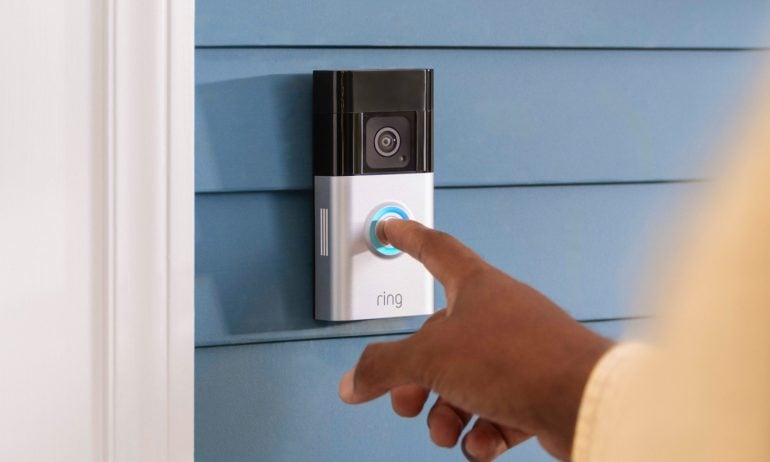
Some or all of the mortgage lenders featured on our site are advertising partners of NerdWallet, but this does not influence our evaluations, lender star ratings or the order in which lenders are listed on the page. Our opinions are our own. Here is a list of our partners.
Ring is a home security provider that offers alarm systems, cameras, video doorbells and other smart home accessories. Because Ring is owned by Amazon, it automatically integrates with an Amazon account and any Alexa-enabled smart home device, though it won’t work with Google Home.
We tested Ring products and were impressed by the company’s dozens and dozens of customizable video and alert features, sleek hardware and affordable monthly monitoring costs.
Pros | Cons |
|---|---|
Rich, customizable video and notification features. | Wi-Fi setup can be challenging and disrupts your existing network. |
Affordable monthly monitoring costs with included cloud storage. | Can only integrate with Alexa, not Google, unless you use a third-party app. |
You can install any Ring product or system yourself, making it a great DIY home security choice, though you can also pay extra to have your alarms professionally installed. Ring’s pro system also has a built-in Wi-Fi router to replace or extend your existing coverage. The Wi-Fi installation process can be a pain, but it’s worth it if you’re using a full Ring alarm system.
Deciding factors | |
|---|---|
One-time costs | $199.99 and up for an alarm kit. |
Monthly fees | None. |
Installation | DIY. Professional setup starts at $159.99 with Ring partner OnTech. |
Video monitoring |
|
Contract | None. |
How much does Ring cost?
Ring offers all of its products for individual purchase or in product bundles. As of this writing, Ring has six different alarm bundles on its website and dozens of other combinations of cameras, doorbells, lights and other products.
The company often runs promotions offering free 30-day trials of Ring Protect Pro and up to 15% off packages. The prices below are list prices of popular bundles.
Package | Price | What you get |
|---|---|---|
Connected Basic Kit | $199.99 | Video doorbell and battery-powered camera. |
Alarm Security Kit, 5-piece | $199.99 |
|
Protected Basic Kit | $299.98 | Everything in the Alarm Security Kit, plus a video doorbell. |
Whole Home Basic Kit | $399.97 | Everything in the Alarm Security Kit, plus a video doorbell and a battery-powered camera. |
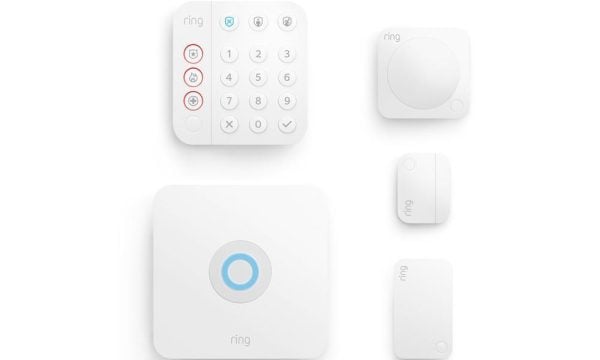
The Ring Five-Piece Alarm Security Kit
Is there a monthly fee for Ring?
There is no required monthly fee to use Ring. However, if you want professional monitoring, Ring’s professional monitoring service is the lowest-priced among the competitors we reviewed. The company also offers several affordable self-monitoring plan options with extra features and cloud storage for video recordings. Ring charges fees on a month-to-month basis, so you won’t need to enter a contract.
How does Ring work?
Setup
Connecting everything to Wi-Fi is the hard part
We found Ring’s setup pretty straightforward, with very clear, detailed setup instructions in the Ring Always Home app. However, it did take a couple of tries to connect individual items to Wi-Fi, an issue that other reviewers have also raised. Wi-Fi was definitely the most complicated part of Ring setup, and we were a little overwhelmed dealing with Ethernet cables and “mesh networks.”
Wi-Fi capabilities. Individual items, such as the camera, don’t have the strongest Wi-Fi capabilities on their own — the one we tried had a harder time finding a connection than competitor SimpliSafe’s, which did so fairly quickly. It worked eventually, though, and the doorbell didn’t have any issues.
Built-in router. Ring’s alarm system has a built-in Eero router, which can either replace or extend your existing Wi-Fi. We were a little confused by the installation guide’s advice not to use the Alarm Pro as a Wi-Fi extender because it “limits certain Ring Protect features,” but it seems like you technically can use it with your existing Wi-Fi (Ring would just prefer you replace it?).
Interference. Ring offers several different Wi-Fi connection options, but they all require setup with the Eero app and interfere with your existing coverage. We tested in an apartment where we couldn’t temporarily shut down our existing Wi-Fi, so we weren’t able to install Ring's Wi-Fi.
Cellular backup. The alarm system’s base station, which everything else connects to, has built-in 24/7 cellular backup capabilities, which worked perfectly and let us fully test the alarm system. This is a good sign in case of a Wi-Fi outage; we wouldn’t recommend running your entire system forever on the backup connection, but it’s good to know it works well in an emergency.
Range extender and backup. Some alarm kits also come with a range extender, which can boost the Base Station signal to reach alarm components farther away. You can also purchase and connect up to four “power packs” ($129.99 each) that stack under the alarm base to provide extended battery backup (up to eight hours each, according to Ring).
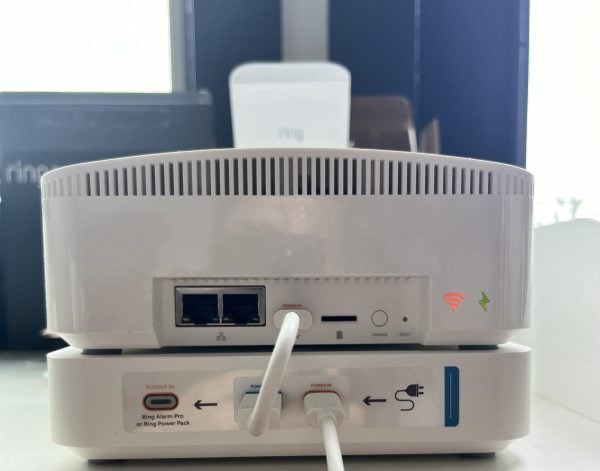
Ring Alarm Base Station and Power Pack
Equipment setup is fairly easy
As far as physical appearance, Ring components are small and aesthetically pleasing; they blend in well on a wall or shelf. Most come in black, white, silver or some combination. Each piece of hardware also comes with a warranty packet and installation guide, which is for physical installation (screwing into the wall, for example), not software setup like the app. You can pay for professional installation, but we didn’t need to.
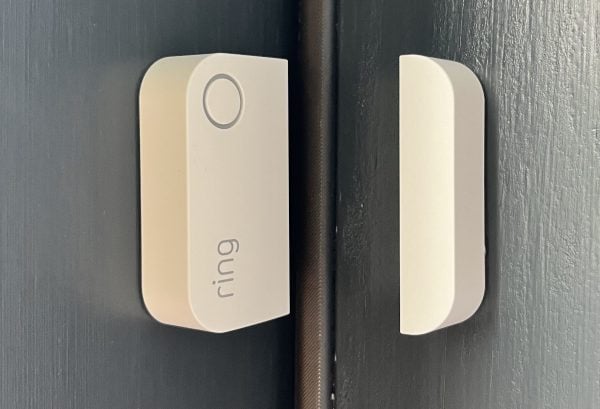
Ring Window and Door Contact Sensor
Wired mode and battery mode. Many of Ring’s devices work in both wired and battery-operated modes and therefore can be installed on a shelf, wall or ceiling. Devices with this option came with screws and charging cables to charge the batteries. Our one complaint here is that the camera we tried (Stick-up Cam Pro) didn’t come with the USB-C needed to put it in “wired” mode, just the micro-USB to charge the battery.
Sticks to the wall. Ring’s door/window and motion sensors are small, sleek and stick well to a wall or door frame; the peel-and-stick backing feels a little nicer than SimpliSafe’s, which were Command strips.
QR code speeds setup. Besides Wi-Fi, Ring makes device setup very clear and painless. When we scanned the QR code on the alarm keypad to activate it, the Ring app automatically pulled up all of the other items in the package for setup with a unique five-digit identification code. This makes it easy to identify each device, scan its QR code and set it up.
Connection confirmation. To activate each device, Ring told me to pull the plastic tab, and the Alarm Pro made a light chime noise to let me know it was connected. Some items, like the camera, announced “Setup Successful” on the device itself when they were up and running, and some items lit up blue. We liked this attention to detail, which made the products feel high-tech. Ring also gives you the chance to test each device’s function during setup by walking in front of it or opening the door, for example.
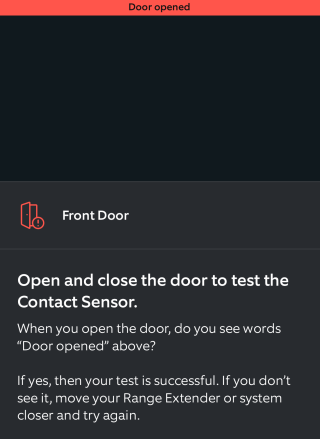
Ring app sensor test
Security
Ring has a range of security features — some are included, others require a paid monthly plan — that can help you maximize the protection the system provides.
Arming and disarming the system
We tested out the “Modes” feature, which lets you arm and disarm your entire system, including cameras and doorbells, all at once. Other home security providers do this automatically, but we liked that Ring allows you to sync your devices or set them to “Off, Home, and Away” modes separately.
To use the Ring app, we had to enter a phone number for two-factor verification and verify with email. The app doesn’t sign you out, so there’s no need to log in every time or use facial or fingerprint recognition. If you have a keypad with your alarm system, you’ll create a unique PIN code to enter to turn off an alarm. We liked that each person who uses the alarm system can create their own personal code.
When the alarm goes off
Similar to SimpliSafe’s “Safeword” feature, you can create a “verbal password” to tell Ring’s monitoring agents not to send emergency services if an alarm is triggered. The agents will call the house, ask if everything is OK and then ask for the password if you indicate that you don’t want emergency services to come. This can prevent intruders from answering the phone and preventing police from responding. Ring recommends you create this password but doesn’t require it.
You can also add a second emergency contact to receive a phone call to verify an alarm (in some jurisdictions, a second contact is required in order to send emergency services).
Speaking of alarm: Ring’s alarm siren is no joke. It’s very, very loud and high-pitched, and it can’t be adjusted like SimpliSafe’s. The siren the camera sets off, on the other hand, is quiet by comparison, and we didn’t find it especially functional as an actual alarm. This is important to think about if you’re considering just getting cameras; they may capture evidence of a crime, but they may not make enough noise to scare or draw attention to the criminal during the event.
You can add information about the people and pets in your home to your app, which Ring monitoring agents will pass on to emergency services during a crisis. This added information can help if you have family members with mobility issues, a tricky gate access code or high-anxiety pets, for example.
If you have a Protect Pro plan, you can use Ring’s in-app SOS feature to contact police, fire or medical services by swiping one of the emergency sliders, which work like a slide-to-unlock phone lock screen. I received a courtesy call from Ring Monitoring in about five to seven seconds after swiping. This can be helpful if you need assistance while you’re away from home, if an intruder has entered while the alarm was disarmed or before an intruder triggers the alarm, for example.
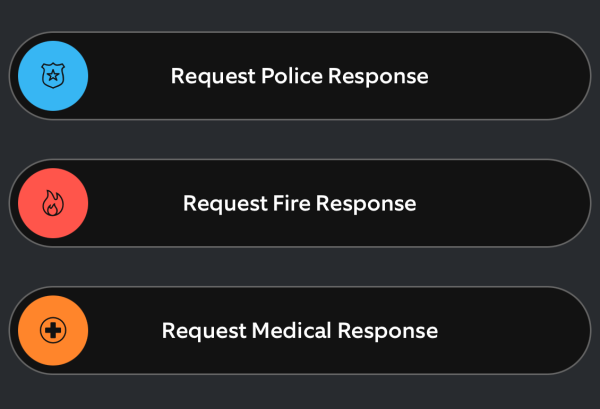
Ring app SOS buttons
Customization
Ring’s devices are jam-packed with some of the most customizable features of any security system we’ve seen, with more options than any home will likely end up needing. Still, there’s something for everyone. Here are our standout options.
Camera
Change motion detection to detect people only or all motion and adjust motion sensitivity on a sliding scale. Note: For us, even in “all motion” mode, the camera didn’t detect light motion, such as a tissue or shoe dropping in front of the camera; we had to really wave something.
Adjust your motion detection zone and create privacy zones to avoid viewing private areas such as a neighbor’s window in the view field. In our test, a privacy zone completely blocked out, not blurred, the set area.
Activate motion warning, which enables a Ring device to announce out loud that motion has been detected, with some cameras (the version of the camera we tried didn’t have this feature).
Disable audio streaming and recording so the app doesn’t replay private conversations.
Change the snapshot capture frequency, recording length, preroll and picture-in-picture footage, as well as include snapshots in push notifications.
Enable HDR and color night vision.
Add multiple human and pet profiles (Ring has pet tags that can connect to your system).
Set some devices, such as the Stick-Up Camera, to wired or battery-powered mode, depending on where you want to use them (indoors or outdoors, wall or shelf, etc.).
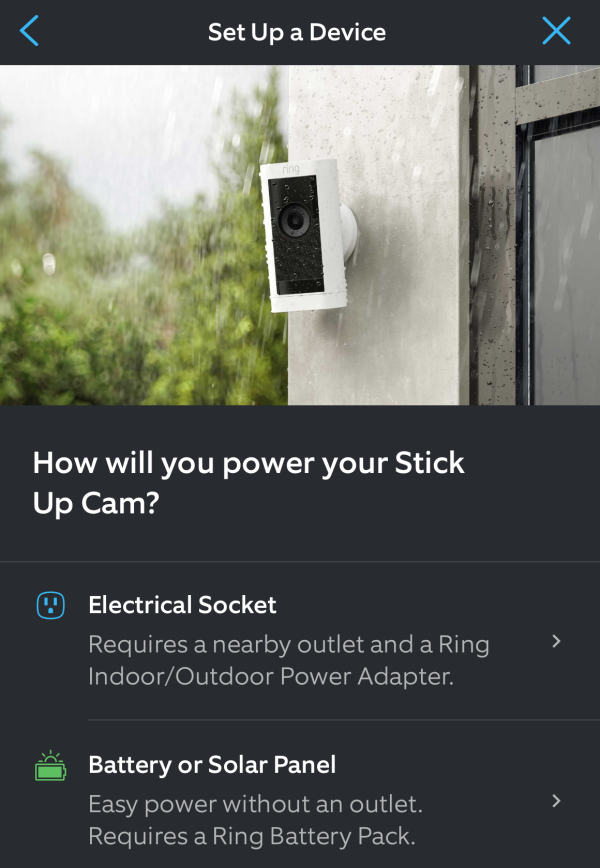
Ring device setup options
Doorbell
Link devices together to work in tandem, so, for example, if your doorbell detects motion, your outdoor camera will immediately turn on a floodlight.
Map out custom “Bird’s Eye Zones” to limit motion detection to a chosen range, such as up to your street so that passing cars don’t trigger alerts. A cool thing about this feature is that you’ll use a satellite view of your street to draw your zone. You can test this feature by walking to the edge of the zone, and you can actually see a visitor’s path to your home, traced on a map, in the app.
Set up “Quick Replies,” which works like an answering machine, in your doorbell, including seasonal greetings. You can watch your visitors’ video messages live in the app, or recorded later. All of the replies are prerecorded, so you can’t create your own, but we had about 15 options to choose from, including a fun “Spring is here, and it looks like you are too!” with birds chirping and bees buzzing in the background.
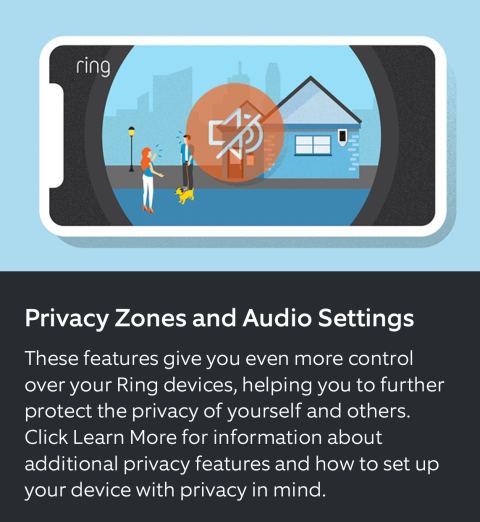
Ring privacy zone and audio setting options
Alerts
Customize alerts in Ring’s “neighbor” feed, which is similar to Nextdoor and Citizen and sends security alerts to other users in your neighborhood. We automatically received push notifications after downloading the app about things like missing pets and squatters, and we had to do a little digging in the app to turn off all of those notifications.
Override your device’s “do not disturb” settings to send priority alerts.
Change the chime volume and app alert tone (there are over 40 options).
Automate your security with a Geofence that snoozes your devices when it detects your (your phone’s) arrival.

Push notification with built-in snapshot
Monitoring
Ring has three paid monitoring options.
Ring’s Basic plan ($4.99 per month) and Plus plan ($9.99 per month) provide advanced video and self-monitoring features.
The Pro plan ($19.99 per month) includes 24/7 professional monitoring, meaning Ring will dispatch emergency services if the alarm goes off.
We got a one-month free trial of the Ring Protect Pro monitoring plan, which comes with the purchase of every Ring device and bundle.
There are no contracts, so you can cancel, downgrade or upgrade your plan anytime.
You can access basic features such as live view and two-way talk with a Ring device without any monthly plan.
Several features made Ring’s plans worth the monthly cost for us:
Digital arming. You’ll need a Ring plan to arm and disarm your system from the app or an Alexa-enabled device or automate modes for specific times. This can be really helpful if you want to manage your alarm while you’re out of the house or while you’re traveling.
Cloud storage for video recordings. All three plans offer cloud storage for video recordings for up to 180 days, which is significantly longer than some competitors. Storing video can be helpful if you want or need a record of an event.
Person and package alerts. All three plans allow you to receive specific notifications when a person or package is detected instead of all-or-nothing motion notifications. This can help you know if your delivery is vulnerable to porch pirates, and it can help you know when somebody is getting too close for comfort.
Advanced video and notification features. All three plans enable your system to automatically capture snapshots during video recording, which you can see in the push notification. You can also view multiple live camera streams simultaneously, receive priority alerts that override your phone’s Do Not Disturb setting and receive detailed event summaries. This can be helpful if you want to keep an eye on more than one thing going on in the house or you want to be alerted about problems that occur while you’re asleep or in a meeting.
Emergency dispatch. Only the Ring Protect Pro plan offers professional monitoring, which enables the Ring monitoring center to dispatch emergency services if an alarm is triggered. This can be helpful if you’re in a dangerous situation or if there’s a break-in or other event while you’re away from the house.
Read more NerdWallet home security reviews based on firsthand testing:
Alternatives to Ring
on SimpliSafe's website
on Arlo's website
on NerdWallet
(Top photo courtesy of Ring)
Methodology





